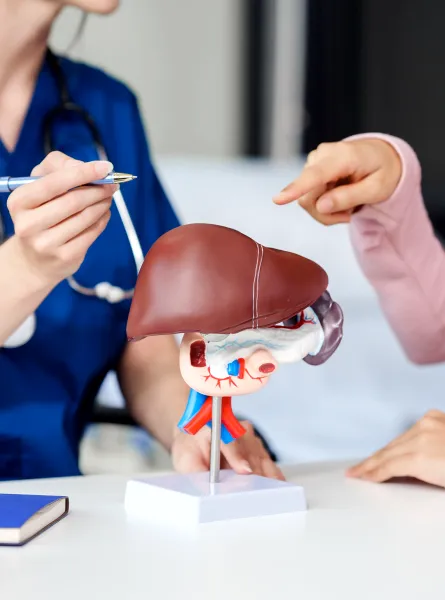
What is SIBO?
Small Intestinal Bacterial Overgrowth (SIBO) is characterized by an excessive presence of bacteria in the small intestine, leading to various gastrointestinal symptoms such as bloating, gas, abdominal pain, diarrhea, or constipation (1,2). SIBO typically results from the failure of the digestive system's protective mechanisms against pathogenic invasion (1). Several conditions, including decreased gastric acidity (gastritis, proton pump inhibitor use), impaired intestinal motility (gastroparesis, narcotic use), structural changes (diverticulosis, ileocecal valve resection, bariatric surgery), immune dysfunction (fibromyalgia, cystic fibrosis, multiple sclerosis), or general digestive dysfunction (irritable bowel syndrome (IBS), Crohn's disease, celiac disease), are associated with a higher prevalence of SIBO (1,2).
How is SIBO diagnosed?
Diagnosing SIBO remains a subject of debate, with varying diagnostic criteria (3,4). The current gold standard for SIBO diagnosis is bacterial culture following intestinal fluid aspiration, with a threshold value of ≥ 10^3 CFU/mL (1-3). However, this method has several limitations, including invasiveness, contamination issues (5), duration, technical difficulty, and cost (2). Endoscopic biopsy of the small intestine is an alternative diagnostic technique providing similar results to fluid culture (6), but the risk of contamination also remains high (1).
Due to these limitations, an indirect test is generally preferred, such as a lactulose or glucose breath test. This test is non-invasive, simple, readily available, and cost-effective (4). Human cells do not produce hydrogen or methane (7), so a high concentration of these gasses in the breath can indicate SIBO (2). The results can be categorized as hydrogen-dominant, methane-dominant, or mixed (2). Of note, patients with a methane-dominant profile are 5 times more likely to suffer from constipation (8). While both tests have the same specificity, some studies have reported higher sensitivity and diagnostic accuracy with the glucose test (4). According to the latest European guidelines on hydrogen and methane breath tests, various protocols and diagnostic criteria are available, although the commonly used threshold values are often 10-12 ppm for 50g of glucose or 10-20g of lactulose (4). The consensus suggests that a threshold value of 5 ppm combined with another technique, such as scintigraphy, could provide better sensitivity without sacrificing specificity (4). On the other hand, the guidelines issued by the American College of Gastroenterology (ACG) recommend a threshold value of ≥ 20 ppm above the normal value at 90-120 minutes for an ingestion of 75g of glucose or 10g of lactulose (1), which would be associated with too many false positives according to the European guidelines (4). Despite their advantages, these tests still require standardization and cautious interpretation due to the high number of false positives (1,4).
Beyond gastrointestinal symptoms, certain nutritional deficiencies may be present, such as vitamin D (1) and vitamin B12 (1,5) deficiencies. Elevated folate levels may also be present as bacteria produce it (1,5), as well as deficiency (due to decreased absorption) or elevation (bacteria synthesis) of vitamin K (5).
SIBO Management
The treatment of SIBO involves 1) achieving remission (reducing bacterial overgrowth), 2) correcting nutritional deficiencies if necessary, 3) treating the underlying cause, and 4) establishing long-term remission maintenance (2,5). SIBO is generally treated with antibiotics (1-3). Several options are available, but Rifaximin has been extensively studied for gastrointestinal disorders (2). However, Rifaximin may be less effective for methane-dominant patients (2). The reason is that the primary methane producer, Methanobrevibacter smithii, is an archaeon that is resistant to several antibiotics (2). One study found that a combination of Rifaximin and Neomycin resulted in a significant reduction in methane production in over 80% of subjects (9,10) and significant improvement in gastrointestinal symptoms (10) in patients with constipation symptoms, whereas using them separately did not have clinically significant effects.
For patients who do not respond to antibiotic treatment, an elemental diet can be a viable option. This treatment involves adopting a liquid diet consisting of easily digestible nutrients for 2 to 3 weeks, and represents a safe and effective alternative (2). In theory, the elemental formula is absorbed in the early part of the intestine, limiting nutrient access for bacteria colonizing the small intestine (11). A study of 124 SIBO patients also observed normalization of the breath test after 3 weeks of the elemental diet (12). Among these patients, a 66% improvement in symptoms was observed (12).
Finally, herbal treatment can be considered if antibiotic therapy does not yield the desired results. According to a study, a treatment consisting of 10 herbal medicines for 4 weeks in 37 patients who tested positive on the breath test resulted in normalization in 46% of patients, compared to 36% of patients treated with Rifaximin, although the difference was not significant (13). However, this promising approach is limited by the lack of studies on the subject.
For long-term remission, addressing the underlying cause of SIBO when possible, remains crucial (2). This aspect will not be discussed in this article.
Nutritional Treatment
Nutritional treatment for remission is still a subject of debate due to the lack of studies on this condition. In general, the goal of nutritional treatment is to reduce symptoms and address deficiencies. The ACG recommends reducing fermentable foods (1). Thus, fermentable fibers such as inulin, sugar alcohols, and fermentable sweeteners like sucralose should be limited (1). The low FODMAP approach has also shown promise in the treatment of SIBO. A literature review published in 2022 concluded that while a low FODMAP diet may result in a decrease in hydrogen production measured by breath tests, an alteration of the intestinal microbiota was observed, highlighting that the addition of soluble fibers may be crucial in achieving eubiosis (14). However, the review focused on patients with irritable bowel syndrome (IBS) rather than SIBO, limiting the interpretation of the results.
Regarding probiotics, a meta-analysis concluded that the introduction of a probiotic can lead to decontamination, a reduction in hydrogen production, and a decrease in abdominal pain (15). However, the use of different multi-strain probiotics in these studies makes it difficult to determine which specific strains are beneficial for treating SIBO (14). To avoid exacerbating bacterial overgrowth, the use of a yeast-based probiotic (Saccharomyces boulardii) is a technique employed by gastroenterology-specialized nutritionists (16).
Lastly, another promising approach in SIBO treatment involves dietary behaviors. According to a literature review, proper chewing, longer meal duration, and regular meal patterns are associated with a decreased risk of developing IBS and a reduction in abdominal pain (14). The migrating motor complex (MMC), particularly phase III, has attracted the attention of many researchers. This contractile activity of the digestive system, which occurs during the interdigestive periods (between meals), helps eliminate food particles, secretions, and excess bacteria into the colon (17) and is crucial for maintaining a balanced intestinal flora (2). It has been observed that patients with IBS or SIBO have a reduced frequency and intensity of phase III of the MMC (18). Thus, maintaining a regular meal pattern and avoiding snacking also seem to be key elements in the prevention and treatment of SIBO (14).
SIBO remains a poorly understood and complex condition, both in terms of its multiple causes and its diagnosis and treatment. Based on current evidence, a personalized nutritional treatment that balances the management of gastrointestinal symptoms and the maintenance of the intestinal microbiota appears to be a crucial element in SIBO treatment. A nutritionist from TeamNutrition will be able to find the best solution for your patients. Contact us to learn more about our services and approach.
References:
- Pimentel, M., Saad, R.J., Long, M.D. & Rao, S.S.C. (2020). ACG Clinical Guideline: Small Intestinal Bacterial Overgrowth. Am J Gastroenterol. 115(2):165-178. https://doi.org/10.14309/ajg.0000000000000501
- Rezaie, A., Pimentel, M. & Rao, S.S. (2016). How to Test and Treat Small Intestinal Bacterial Overgrowth: an Evidence-Based Approach. Curr Gastroenterol Rep. 18(2):8. https://doi.org/10.1007/s11894-015-0482-9
- Rej, A., Potter, M.D.E., Talley, N.J., Shah, A., Holtmann, G. & Sanders, D.S. (2022). Evidence-Based and Emerging Diet Recommendations for Small Bowel Disorders. Am J Gastroenterol, 117(6):958-964.https://doi.org/10.14309/ajg.0000000000001764
- Hammer, H.F., Fox, M.R., Keller, J., Salvatore, S., Basilisco, G., Hammer, J., Lopetuso, L., Benninga, M., Borrello, O., Dumitrascu, D., Hauser, B., Herszenyi, L., Nakov, R., Pohl, D., Thapar, N., Sonyi, M. & European H2-C4-breath test group. (2021). European guideline on indications, performance, and clinical impact of hydrogen and methane breath tests in adult and pediatric patients: European Association for Gastroenterology, Endoscopy and Nutrition, European Society of Neurogastroenterology and Motility, and European Society for Paediatric Gastroenterology Hepatology and Nutrition consensus. United European Gastroenterol J. 10(1):15-40. https://doi.org/10.1002/ueg2.12133
- Quigley, E.M.M., Murray, J.A & Pimentel, M. (2020). AGA Clinical Practice Update on Small Intestinal Bacterial Overgrowth: Expert Review. Gastroenterology. 159(4):1526-1532. https://doi.org/10.1053/j.gastro.2020.06.090
- Chandra, S., Dutta, U., Noor, M.T., Taneja, N., Kochhar, R., Sharma, M. & Singh, K. (2010). Endoscopic jejunal biopsy culture: A simple and effective method to study jejunal microflora. Indian J Gastroenterol. 29(6):226–230. https://doi.org/10.1007/s12664-010-0072-6
- Levitt, M.D. (1971). Volume and composition of human intestinal gas determined by means of an intestinal washout technic. Gastroenterology. 59:921–929. https://doi.org/10.1056/nejm197106242842502
- Kunkel, D., Basseri, R.J., Makhani, M.D., Chong, K., Chang, C. & Pimentel, M. (2011). Methane on breath testing is associated with constipation: a systematic review and meta-analysis. Dig Dis Sci. 56:1612–1618. https://doi.org/10.1007/s10620-011-1590-5
- Low, K., Hwang, L., Hua, J., Zhu, J., Morales, W. & Pimentel, M. (2010). A combination of rifaximin and neomycin is most effective in treating irritable bowel syndrome patients with methane on lactulose breath test. J Clin Gastroenterol. 44:547–450. https://doi.org/10.1097/mcg.0b013e3181c64c90
- Pimentel, M., Chang, C., Chua, K.S., Mirocha, J., DiBaise, J., Rao, S. & Amichai, M. (2014). Antibiotic treatment of constipation-predominant irritable bowel syndrome. Dig Dis Sci. 59(6):1278–1285. https://doi.org/10.1007/s10620-014-3157-8
- Winitz, M., Adams, R.F., Seedman, D.A., Davis, P.N., Jayko, L. Hamilton, & J.A. (1970). Studies in metabolic nutrition employing chemically defined diets. II. Effects on gut microflora populations. Am J Clin Nutr. 23(5):546–559. https://doi.org/10.1093/ajcn/23.5.546
- Pimentel, M., Constantino, T., Kong, Y., Bajwa, M., Rezaie, A., & Park, S. (2004). A 14-day elemental diet is highly effective in normalizing the lactulose breath test. Dig Dis Sci. ;49(1):73-77. https://doi.org/10.1023/b:ddas.0000011605.43979.e1
- Chedid, V., Dhalla, S., Clarke, J.O., Roland, B.C., Dunbar, K.B., Koh, J., Justino, E., Tomakin, E. & Mullin, G.E. (2014). Herbal therapy is equivalent to rifaximin for the treatment of small intestinal bacterial overgrowth. Glob Adv Health Med. 3(3):16–24. https://doi.org/10.7453/gahmj.2014.019
- Wielgosz-Grochowska, J.P., Domanski, N., & Domanski, M.E. (2022). Efficacy of an Irritable Bowel Syndrome Diet in the Treatment of Small Intestinal Bacterial Overgrowth: A Narrative Review. 14(16):3382. https://doi.org/10.3390/nu14163382
- Zhong, C., Qu, C., Wang, B., Liang, S., & Zeng, B. (2017). Probiotics for Preventing and Treating Small Intestinal Bacterial Overgrowth. J. Clin. Gastroenterol.51(4): 300–311. https://doi.org/10.1097/mcg.0000000000000814
- Duker Freuman, T. (2020). The Bloated Belly Whisperer: A Nutritionist's Ultimate Guide to Beating Bloat and Improving Digestive Wellness. (1er éd.). St. Martin's Griffin.
- Code, C.F. & Marlett, J.A. (1975). The interdigestive myo-electric complex of the stomach and small bowel of dogs. J Physiol. 246(2):289–309. https://doi.org/10.1113/jphysiol.1975.sp010891
- Pimentel, M., Soffer, E.E., Chow, E.J., Kong, Y. & Lin, H.C. (2002). Lower frequency of MMC is found in IBS subjects with abnormal lactulose breath test, suggesting bacterial overgrowth. Dig Dis Sci.47(12):2639–43. https://doi.org/10.1023/a:1021039032413





